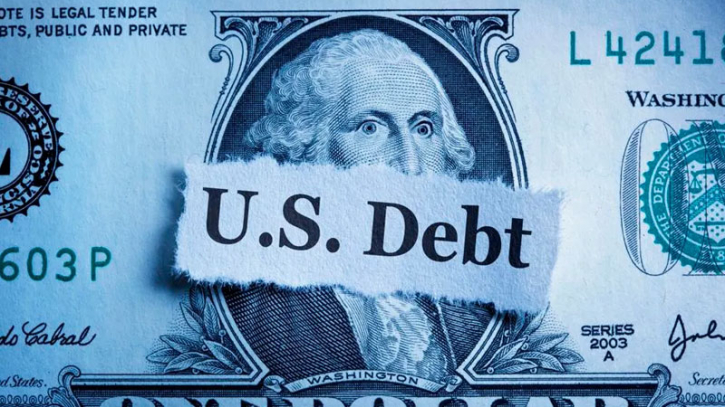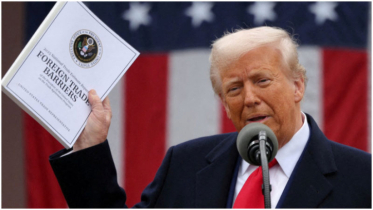Debt is America's golden goose. Fitch can't kill it

On August 1, credit rating agency Fitch downgraded the United States from its highest triple AAA rating to AA+. Two of the three leading ratings agencies now rate the US at their second highest tier – Standard and Poor’s previously downgraded the US to AA+ in 2011, leaving only Moody’s with the US at the highest rating.
However, the market impact has been minimal. There was no significant movement in the price and yield of US Treasuries, the benchmark borrowing mechanism, nor in the value of the US dollar against other currencies – even after the US Treasury announced the following day that it would increase borrowing by $7bn in the next quarter and add another $6bn in its debt auctions in the coming month.
The reality is that there is ample demand for US debt, which plays a vital role not only in the US financial system but across the globe.
Consider the two largest economies below the US: China and Japan. One is a rival, the other an ally. Yet, both are the world’s largest buyers of US Treasuries, which serve not only as the source of US dollar holdings for global reserves but are also the predominant instrument in which international trade is financed.
US Treasuries account for roughly half of cross-border loans and trade financing arrangements globally. This grants the US what former French President Valery Giscard d’Estaing called its ‘exorbitant privilege’.
The privilege gives the US not just substantial economic benefits, but also political ones. It is the reason that US sanctions sting so hard and have such an extra-territorial reach. Companies and countries that need dollars cannot risk running afoul of them.
It also means that the US Federal Reserve’s baseline interest rate has a determinant impact on interest rates globally; when the Fed raises rates to fight inflation, other countries follow suit or risk seeing their own currencies depreciate against the dollar as capital can seek a higher relative return in the US in such periods. This is precisely what played out in 2022 when the US dollar repeatedly reached 20-year highs despite the US simultaneously recording its highest inflation rates over that period.
This privilege also refers to US’s ability to issue debt with far less risk than other countries. They need dollars, and only the US can issue them.
To be sure, there is also a strong appetite for the sovereign debts of other countries. Japan’s government-debt-to-GDP ratio for example is around 221 percent, far in excess of the US’s 115 percent. Even Italy reports a higher ratio than Washington, despite its BBB rating from Fitch – though it also benefits from the European Union’s AAA rating from all three agencies, in itself a mystery given the lack of any definitive criteria for bailouts of Eurozone members.
Indeed, the demand for the few securities issued with the EU’s backing is far lower than that for those issued with US backing.
Fitch’s action, therefore, comes across as a surprise. Famed economist Mohamed El-Erian noted as much, asking, “Why now … when you look at the reason, you scratch your head as to the timing?”
Fitch gives its primary reason as “deterioration in standards of governance over the last 20 years, including on fiscal and debt matters, notwithstanding the June bipartisan agreement to suspend the debt limit until January 2025”.
That point is well-taken. The debt ceiling standoffs are driven by partisanship; Democrats regularly back the ceiling – or even support abolishing it. The US is one of just two countries with such a limit, alongside Denmark, and the Biden administration has openly questioned whether it is constitutional. Republicans do too, at least when there is a Republican in the White House. It is when the US suffers from a divided government that the issue becomes so heated, and it was a similar standoff in 2011 that led S&P to first downgrade the US back then.
At the time, the move raised concerns about the impact on financial markets, in particular, about bank and pension mandates to buy AAA-rated securities and similar language in financial agreements used to manage risk. However, these concerns were quickly revealed to be inflated, and mandates were swiftly adjusted where there was potential concern.
There rightly appears to be far less concern this time around. Fitch also noted that the US rating ceiling would remain at AAA, meaning that the highest-rated corporates such as Apple do not need to worry about their ratings being affected, nor do US-backed institutions such as the various development banks that underpin its leading role in the international economic order.
Nevertheless, there are those who claim that Fitch’s action risks causing investors to treat US debt differently, or to accelerate their search for another reserve asset. The reality though is that no genuine alternative appears on the horizon.
There has been talk about the Brazil-Russia-India-China-South Africa (BRICS) grouping contemplating a trading currency at its upcoming summit in Johannesburg. Russian President Vladimir Putin pitched the idea at the BRICS summit last year and has continued to rail against the dollar’s dominance. But the bloc quietly dropped the news that new currency talks will not be on the agenda, a day after host South Africa announced that Putin would not be attending at a time when he faces an arrest warrant from the International Criminal Court related to the war in Ukraine.
Fitch itself recently declared that the US dollar appears set to remain the “pre-eminent global currency” through 2050. Global demand for dollars, and Treasuries, will more than cover the US’s debt issuance.
Professor Daniel McDowell, author of the must-read book on risks to the US dollar system, Bucking the Buck: US Financial Sanctions and the International Backlash Against the Dollar, notes that “everything Fitch mentions in their rating is old news. Investors can make up their own minds about US debt and markets consistently say it’s the safest option available”.
To be fair, Fitch’s explanation for the downgrade correctly focuses on the US political environment, rather than the role of the dollar in the international economic order or the US domestic economy. But precisely because of its role in this international economic order, it is time to abandon shibboleths about US debt, including the idea that a sovereign credit rating matters, or that US debt risks becoming unsustainable by comparing it to a household balance sheet.
After all, the Federal Reserve’s interest rate is often referred to as the ‘risk-free’ rate because of the US government’s ability to print more dollars if it needs to in order to meet its commitments.
It is long overdue for the US to recognise that debt issuance is Washington’s golden goose. The market shows the golden eggs it lays are still very much in demand.
Republicans have blamed the Biden administration for the downgrade, but if they want to restore the AAA rating, the path to doing so is very simple: Abolish the debt ceiling once and for all.
Source: AlJazeera
.png)




